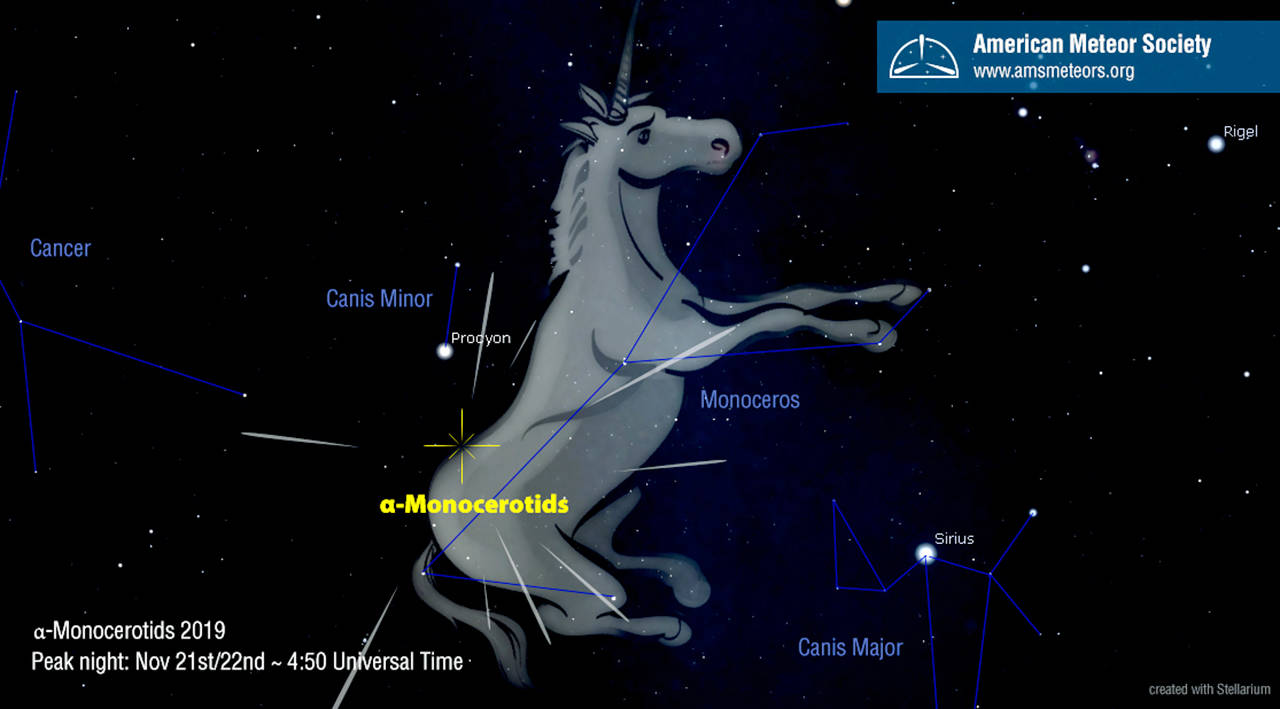EVERETT — It could be a dud or an astronomical hit.
Tune into the sky Thursday night to find out how many shooting stars to give the alpha Monocerotids meteor storm.
Say what?
The debut of what is dubbed “Unicorn Meteor Storm” lacks the hype of “Frozen II.”
“Nobody had heard about it until the last week or so,” said Mark Folkerts, president of Everett Astronomical Society. “They’re saying, ‘Hey, by the way, there might be there this surprise burst of meteors.’”
It depends if the sky is clear and the science adds up.
It’s a prediction that is getting global attention by scientists and skygazers.
“They think there’s a potential for up to 400 meteors per hour,” Folkerts said.
Meteors are the breadcrumbs that comets leave behind. Meteor showers are sparked when the Earth passes through a field of cosmic debris.
Start looking for shooting stars at 8 p.m. Pacific Time. The outburst is expected to end by 9.
One hour. That’s it. That’s part of the rarity of this mysterious comet event.
The National Weather Service has forecast mostly clear skies over Everett on Thursday evening with a chance of patchy fog.
Folkerts said the best viewing area is away from streetlights, glare and trees, in a place with a wide view of the sky. The darker your sky, the more meteors you’ll see.
You won’t see any unicorns. Sorry.
Unicorns are mythical creatures, but this one is legit.
The meteors radiate from the faint constellation of Monoceros, which is Greek for unicorn. It is located to the left of powerhouse Orion.
“Meteor showers are usually referred to by the constellation behind where they appear to come from,” Folkerts said. “The common name is unicorn.”
The alpha Monocerotids are active every year around this date, but it’s usually a sprinkling of meteors. The four outbursts were in 1925, 1935, 1985 and 1995.
As comets orbit the sun, they shed particles of gas or dust.
“Comets are composed mostly of ice and bits of rocks and so forth. When they get close to the sun it vaporizes the ice and releases particles,” Folkerts said. “As the comet goes its orbit, it’s always losing bits of itself.”
Over time, those particles travel at different speeds and spread out along the path of the comet’s orbit. They tend to be kind of bunched up, based on proximity to the sun.
When the Earth’s orbit intersects once a year with the comet’s orbit, those particles can form a meteor shower — or a storm, if there’s gobs.
Scientists try to calculate when those bunched-up particles might be ready for a prime-time show.
“It is a prediction based on fairly limited data,” Folkerts said. “Like a lot of things in astronomy, we don’t know for certainty what is going happen.”
Here’s something for certain: The next meeting of Everett Astronomical Society is set for 3 p.m. Saturday at the main Everett Library.
Andrea Brown: abrown@heraldnet.com; 425-339-3443. Twitter @reporterbrown.
Talk to us
> Give us your news tips.
> Send us a letter to the editor.
> More Herald contact information.

























